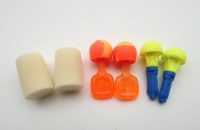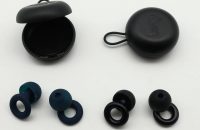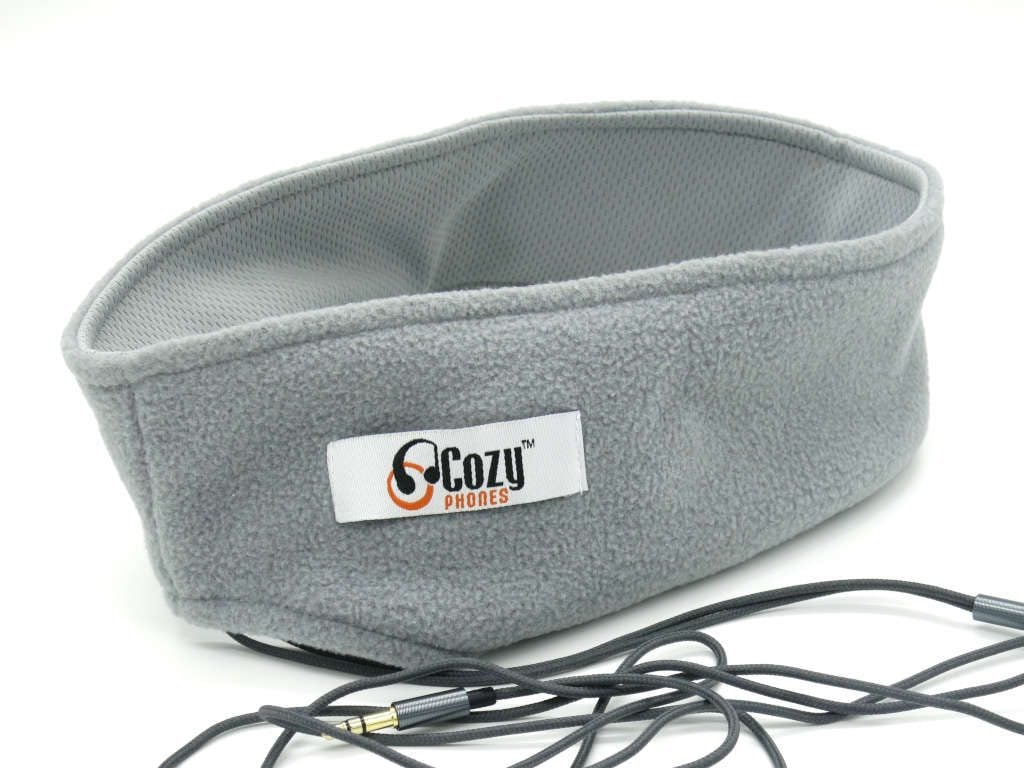
Most headphones and earbuds are not suitable for side sleepers. And these days, I sleep mostly on the side.
Headphones are too bulky, and if earbuds stick out just a little too much, they get pushed into my ear, making them uncomfortable to sleep with.
This is why I got interested in CozyPhones. This review focuses on the CozyPhones New Contour Series (with mesh lining).
To drift to sleep, I need to have about half an hour of quiet without any sudden noises. The sound of my air conditioner turning on, creaking noises coming from above, or a fridge door being slammed, all these take me right out of falling asleep and back to being alert. If this happens three of four times, I might not be able to get to sleep for an hour or more.
Listening to white noise or steady ambient soundscapes like water streams is one of my favorite ways to mask environmental noises and drift away.
What are CozyPhones?
CozyPhones are headband sleep headphones with flat, padded speaker inserts. The idea is that you can even lie on your side without discomfort.
You put them on just as you would put on a regular sports headband. The inner lining is of cool, breathable mesh material, while the outer side is soft fleece. 

The 3.5-mm headphone plug fits most phones, tablets and MP3 players.
Unfortunately, some newer phones, such as the iPhone 8 and iPhone X don’t feature a headphone jack anymore.
But you can make CozyPhones work very well with these devices too. For more on this, see below.
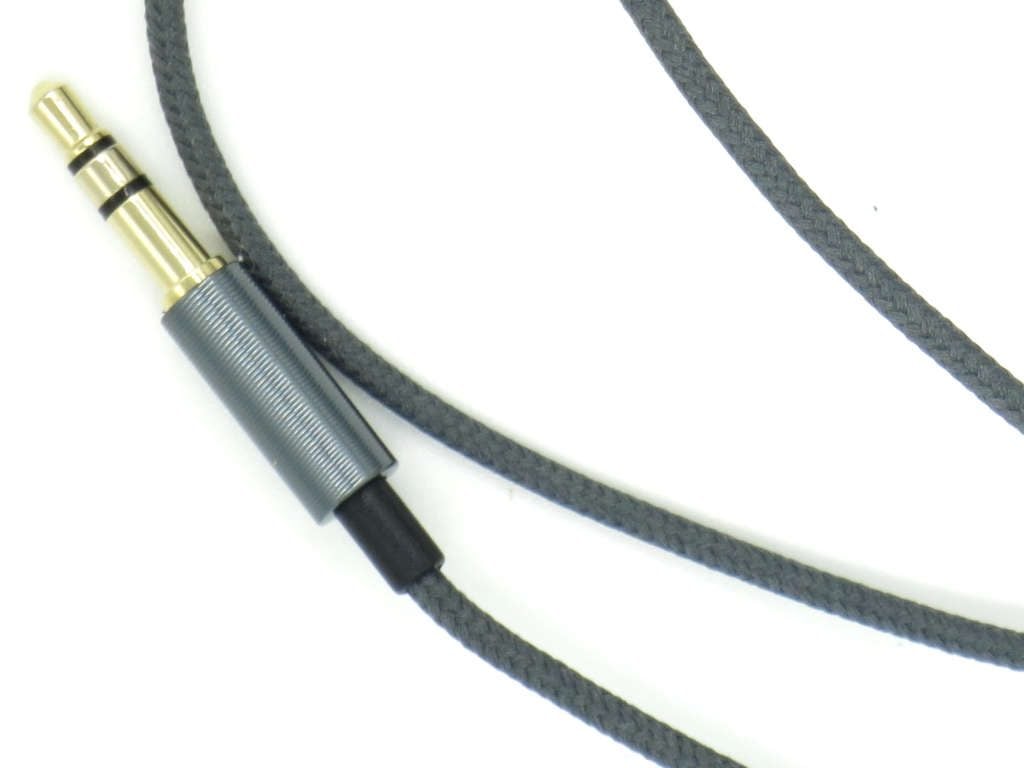
The speaker inserts are removable, so you can wash the headband. To avoid tangling, the cable is braided and about 54 inches long.
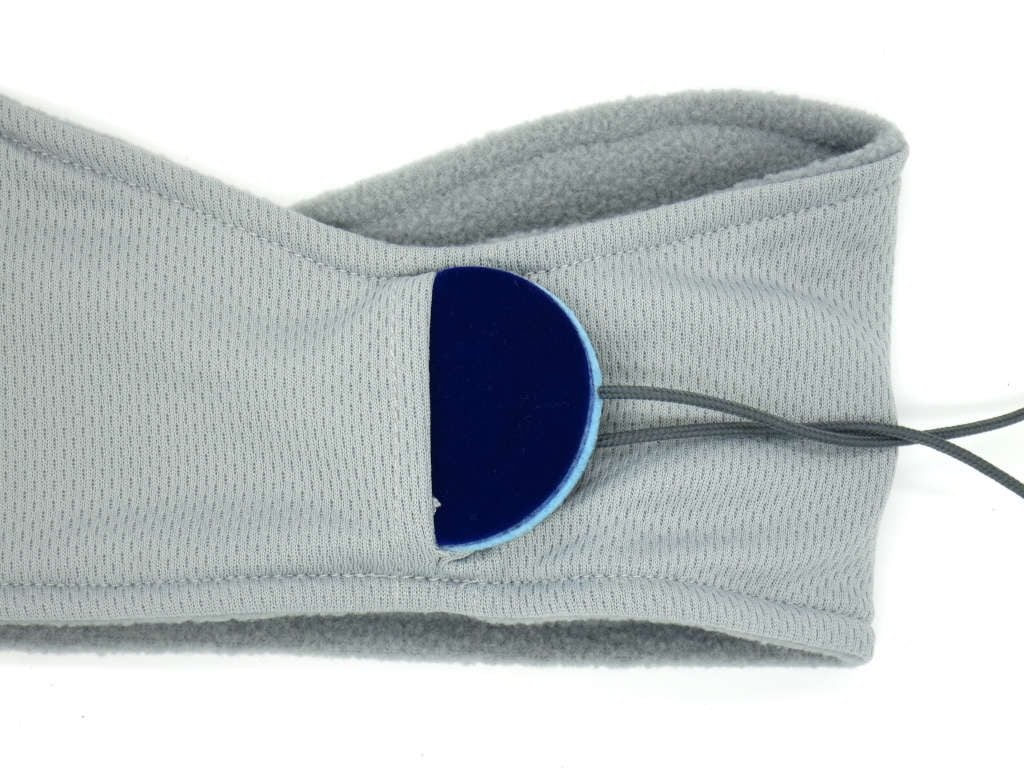 When reinserting the speakers after washing, the blue side has to face the mesh lining (the black side faces the fleece).
When reinserting the speakers after washing, the blue side has to face the mesh lining (the black side faces the fleece).

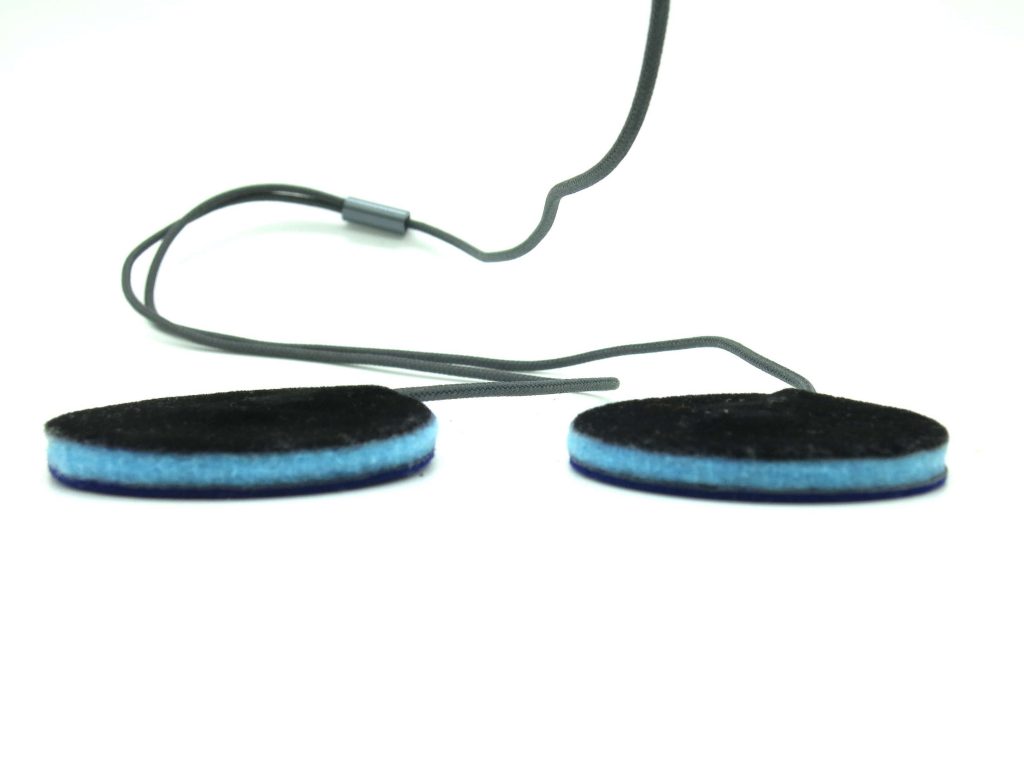
First Impressions
When I first got the CozyPhones, I started wearing them in a coffee shop. I had to push the speakers further in to make them sit on my ear. After this adjustment, they were easy to put on and take off.
I went to the bath room just to make sure they didn’t look ridiculous: they look fine—just like a headband with ear warmer.
I then tried them with various types of music and podcasts.
For the size of the speakers, they sound surprisingly good. Mind you, they are not high fidelity Beyerdynamic or Bose headphones, but music sounds pleasant and balanced. The highs are detailed, and voices are not muffled. The bass should be a bit stronger though. It is comparable with many earbuds in the 20-dollar range.
Voices sound fuller than when played through cheap in-ear headphones. These headband phones should work just fine for podcasts and audio books.
How comfortable are CozyPhones?
They are sleep headphones so they’d better be comfortable. They are designed for both back and side sleepers.
If your head size is between 22 and 24 inches, the CozyPhones Contour Series (reviewed in this post) should work fine. I have a “23-inch head,” and I find them very comfortable to wear when sitting or lying on my back. They don’t put pressure on my head or ears.
If you have a smaller head (20”- 22”), the Adult Fleece model is a better fit.
If you are between sizes, I would still go for the Contour Series because I prefer the mesh lining.
Do they feel hot?
I live in a hot climate, but I use air conditioning throughout most of the day and while sleeping. At 25 degrees Celsius (77 Fahrenheit), the CozyPhones don’t feel hot. Unless it was winter, I wouldn’t wear them as a sports headband for running outside though.
How comfortable are they when sleeping on your side?
They work for me, when I sleep on my side, but depending on the pillow, I have to make adjustments.
I first wore them for a full night while sleeping in a hotel room.
I had no problems falling asleep, but when I woke up to go to the bathroom, my ears felt a bit sore. The hotel pillow was thick and pushed quite hard against my head and against the CozyPhones. Despite being slim and soft, the speakers still exerted some pressure on my ears. After pulling down the part that covers my ears to the point where the upper earlobe became touchable, I was able to sleep comfortable again.
Compared to most earbuds, these sleep headphones nevertheless worked very well.
My pillow at home is only half as thick and a lot softer. Sleeping on that pillow, CozyPhones usually remain comfortable. But because the speakers can move in the headband or the headband itself might move, sometimes they don’t. Then I wake up and have to re-position the speakers.
Another trick to make them comfortable with a thicker and denser pillow is to push the little speaker-inserts more to the front of your head, so that the speakers don’t sit on the hard cartilage rim pointed to by the red arrows in the image below.
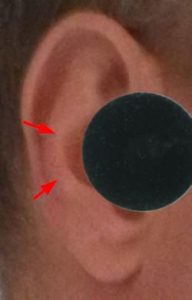
In this position they don’t sound quite as good and don’t go quite as loud, but they are still good enough for listening to music or white noise to fall asleep.
So if you are a side sleeper, expect some adjustments and wiggling.
How do CozyPhones sound and good for?
I have tried them with white noise, instrumental music, music with vocals, podcasts, and even rock. They sound pleasant and non-intrusive. The bass is present, but it is a bit weak.
It gets stronger when you press the speakers to your ear, so it will somewhat depend on your pillow if you are a side sleeper.
CozyPhones work well for meditation, listening to ASMR, brain entrainment with binaural beats, and noise masking with white noise.
Noise blocking
Headband headphones per se don’t block noise; the material might muffle environmental sounds a bit, but you’ll still hear your alarm, and unfortunately your neighbor’s dog or your snoring partner.
CozyPhones are neither noise isolating (passive) nor noise cancelling (with electronics).
The way to combat moderate noise with these headphones is through noise masking. You play either relaxing music, white noise, or ASMR to mask (i.e., drown out) environmental noise. This works well for creaking floors, dripping water, a TV playing in an adjacent room, and noises that are further away.
Noise masking also works to block soft snoring, but if the snoring gets loud, these sleep headphones alone won’t be enough. You would have to turn up the volume too much.
But, because the speakers are on-the-ear, you can also use them in combination with earplugs underneath.
If you need to block loud snoring or other noises that keep you from falling asleep, get yourself a good pair of foam earplugs that block snoring. These will attenuate the noise substantially. On top of the earplugs wear the CozyPhones and mask the remainder of the intruding noise with white noise. I recommend you try the myNoise white noise app for this purpose.
This is a big advantage of sleep headbands and other on-the-ear-headphones. You can’t combine earbuds with earplugs.
The combination of sleep headphones and earplugs is a very effective (and economical) noise blocking solution for side sleepers and back sleepers alike. It works so well that I can sleep through almost anything. Exceptions are a booming bass and people stomping in an upstairs apartment.
How do you still hear your alarm? You could wear a watch with vibration alarm or have your phone’s alarm play through the headphones.
Just make sure you don’t miss any fire alarms.
Tinnitus Masking
Loud tinnitus can keep sufferers awake for long hours. Tinnitus masking works very similar to masking external noises. Headband headphones together with a white noise app for your phone or iPad are a very economical solution for masking your tinnitus so that it doesn’t annoy you anymore. Ideally you want an app that allows you adjust the pitch of the white noise to mask your tinnitus at as low a volume as possible.
How to use CozyPhones with an iPhone 8 or X, or other phone without headphone jack?
How to get rid of the wires if you toss and turn a lot?
The missing headphone jack on modern phones is increasingly becoming a problem.
One solution for iPhones is to use a ligthtning-to-headphone-jack adapter.
Going wireless might be more practical.
If you are a sleeper that tosses and turns a lot during the night, why not completely get rid of the wired connection between your phone and your headphones?
I use the Loop R8 Bluetooth receiver, a tiny and very light adapter with clip that accepts the cable from the CozyPhones and connects wireless to my phone.
I just clip it to my shirt, tuck excess cable under my shirt and place the phone on the nightstand. Now I can toss and turn all I want.
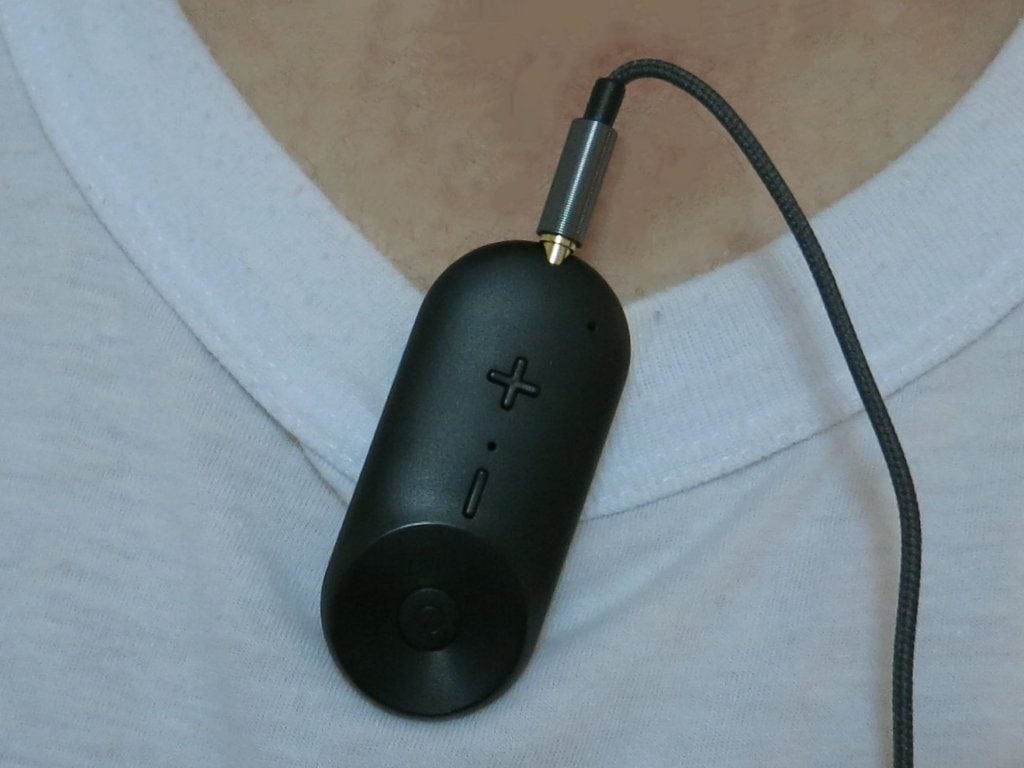
The Loop R8 also has tactile controls for volume, pause and skipping tracks. It even has a microphone for accepting phone calls.
During the night, I sometimes need to readjust the volume. Now I just have to feel the buttons on the Loop and turn it up or down.
Thanks to this little helper, I completely avoid getting entangled in the cable or pulling my phone off the night stand. I can even go to the bathroom without thinking twice.
At a moderate volume, the Loop R8’s battery lasts me for 8.5 hours before having to recharge. This gets me through the night.
Many Bluetooth receivers have a very small battery and will only give you five to six hours of continuous play time. This may be OK, if you only want to play music to fall asleep, but if you need noise or tinnitus masking throughout the night it’s too short.
Wrap Up
CozyPhones are economical and pleasant sounding sleep headphones. They are good for listening to music, podcasts, and soundscapes in bed, as well as noise and tinnitus masking. The highs are detailed. I would like the bass to be stronger though, in particular for masking lower frequency environmental sounds.
If you are a side sleeper, depending on your pillow, you may need to experiment with the speaker position.
To make them wireless and connect to phones without a headphone jack, use CozyPhones Contour together with a Bluetooth receiver, such as the Loop R8.
If you need to block very loud noise, consider earplugs underneath. If you need some advice on selecting suitable earplugs, read my post on earplugs for snore blocking.
Disclosure: I received a CozyPhones sample in exchange for an honest review. The opinions expressed here are my own and not influenced by the company in any way.

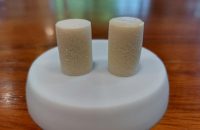

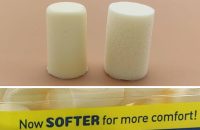
![Flents Quiet Time vs Quiet Contour vs Quiet Please [tested] Flents Quiet Time vs Quiet Contour vs Quiet Please [tested]](https://noisyworld.org/wp-content/uploads/2021/06/flents-foam-earplugs-comparative-review-200x130.jpg)
